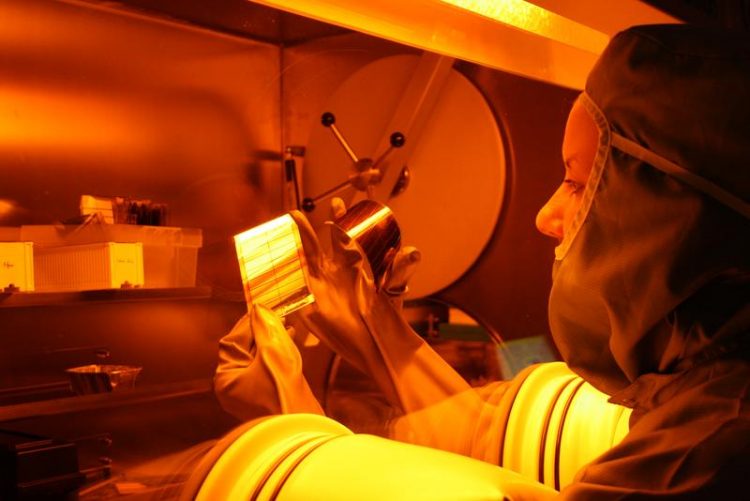Smart printing: power generating films and luminescent glass

Flexible photovoltaic elements, manufactured on Fraunhofer IAP`s own pilot plant. Fraunhofer IAP
They turn light into electricity or vice versa: the inkjet inks developed by researchers at the Fraunhofer IAP can be printed on solid substrates as well as on flexible foils. In effect, solar cells and organic displays can be produced fast and cost-effectively.
Together with research partners, the Fraunhofer scientists have developed methods to print organic photovoltaic elements for use in architecture and for the textile industry on film. With a solar module as façade element and a power-generating jacket, they present the potential of their work at the fair.
Printed displays rolled up?
Also for displays, printing processes are utilized at the Fraunhofer IAP. Using specially developed inks from organic light sources and quantum dots, the researchers print, for example, organic light-emitting diodes (OLEDs) and quantum dot-based LEDs (QLEDs). The displays can also be printed on different materials. Printing on film makes them flexible to some degree.
“Until we can flexibly roll up our televisions, we still have a little research to do”, explains Dr. Armin Wedel, head of the research division Functional Polymer Systems at the Fraunhofer IAP. “Although there are already curved and even scrollable displays, they still have to be rolled up on rigid rolls with a defined diameter,” says the OLED specialist.
ESJET printing for high-resolution OLEDs
New perspectives for the production of printed displays result from the use of ESJET printing (electrostatic printing). The scientists at the Fraunhofer IAP are working on this procedure together with twelve other partners within the project Hi-Response, which is funded by the European Union.
The ESJET printing process allows the use of a wider range of inks, as even very viscous inks can be processed. The drop-on-demand system also makes it possible to set the thickness of the printed layer very precisely. The printed structures can be as small as 1 micron. In the future, the printing of high-resolution, active-matrix-driven OLEDs should be possible.
Quantum materials for the display industry
In addition to OLEDs, the IAP scientists are also researching QLEDs based on indium phosphide quantum dots. They are free of conventionally used toxic cadmium. The results so far are groundbreaking for the industry. Indium phosphide-based QLEDs are gradually catching up on the performance advantage of cadmium-based systems in many areas. Regarding luminance, they are already outperforming cadmium-based QLEDs.
Dr. André Geßner presents the research results in his presentation:
„Concept For Full Color QD-Displays“
Thursday, April 12, 10.00 to 10.20 a.m.
Estrel Convention Center, Berlin; Room II
Funding
Solar powered LED illuminated bike jacket | This project has received funding from BMBF within the framework of the project EPOS, BMBF FKNZ 03EK2529.
Photovoltaics as a substitute for ITO electrodes | This project has received funding from the European Union‘s H2020-NMP-PILOTS-2014 programme under grant agreement No. 646296).
ELQ-LED | This project was funded by the BMBF under grant number 13N14421.
The Fraunhofer IAP
The Fraunhofer Institute for Applied Polymer Research IAP in Potsdam-Golm, Germany, specializes in research and development of polymer applications. It supports companies and partners in custom development and optimization of innovative and sustainable materials, processing aids and processes. In addition to the environmentally friendly, economical production, functionalization and processing of polymers in the laboratory and pilot plant scale, the institute also offers the characterization of polymers.
Synthetic petroleum-based polymers as well as biopolymers, polymers from renewable raw materials and chemically, physically or biologically functionalized polymers are in the focus of the institute’s work. The applications are diverse, ranging from biotechnology, medicine, pharmacy and cosmetics to electronics and optics as well as applications in the packaging, environmental and wastewater engineering or the aerospace, automotive, paper, construction and coatings industries. | Director: Prof. Dr. Alexander Böker
Media Contact
More Information:
http://www.iap.fraunhofer.deAll latest news from the category: Trade Fair News
Newest articles

NASA: Mystery of life’s handedness deepens
The mystery of why life uses molecules with specific orientations has deepened with a NASA-funded discovery that RNA — a key molecule thought to have potentially held the instructions for…

What are the effects of historic lithium mining on water quality?
Study reveals low levels of common contaminants but high levels of other elements in waters associated with an abandoned lithium mine. Lithium ore and mining waste from a historic lithium…

Quantum-inspired design boosts efficiency of heat-to-electricity conversion
Rice engineers take unconventional route to improving thermophotovoltaic systems. Researchers at Rice University have found a new way to improve a key element of thermophotovoltaic (TPV) systems, which convert heat…



